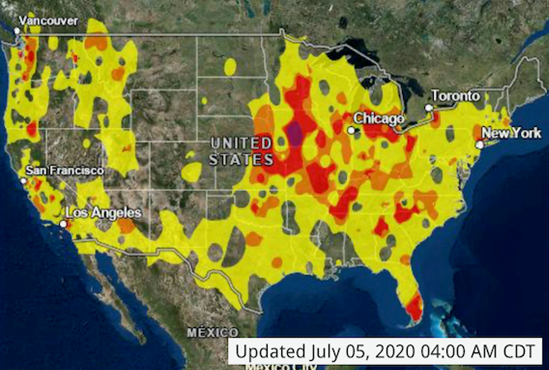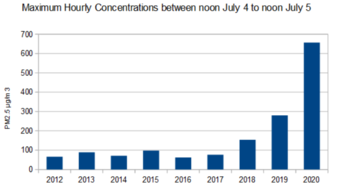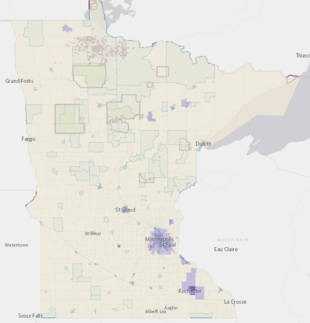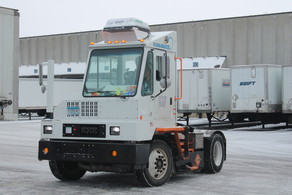|
Currently, Minnesota facilities with air permits voluntarily report emissions of Hazardous Air Pollutants (HAPs, also known as air toxics) on a triennial basis to the Minnesota Pollution Control Agency. This information is used to evaluate health risks statewide (in MNRISKS) and in areas of concern for environmental justice. MPCA and local agencies use this information to focus grants in areas with high air pollution exposure and prioritize enforcement screening. Discussions are under way to make this reporting mandatory.
MPCA held a webinar on July 16th about the current Minnesota air toxics reporting structure and what a potential mandatory reporting rule could include. To review the webinar and presentation materials, visit the MPCA’s website.
For more information about the webinar or potential rule changes, contact Maggie Wenger (maggie.wenger@state.mn.us or 651-757-2007).
During the 2020 session, the Legislature passed a ban on the use of trichloroethylene (TCE), effective on June 1, 2022. As an initial step towards implementing this ban, on July 13, 2020, the MPCA issued 1,953 Request for Information (RFI) Letters to all facilities in Minnesota with an air emissions permit requesting information on their use of TCE. This RFI was similar in content to an earlier RFI that was issued to facilities known to have TCE emissions. The RFI asks facilities to confirm whether or not they are currently using TCE or have in the past five years. They are also asked to document actions being taken to reduce TCE use, identify TCE alternatives that have taken the place of TCE in their operations, and at what quantities those alternatives are being used. The legislation also requires that any chemicals used to replace TCE be less toxic than TCE; therefore, documenting the alternative compounds is important. Regulated parties are asked to submit their information directly to Marc Severin (marc.severin@state.mn.us). Facilities are not required to respond to the RFI if they have not used TCE since 2015. For more information, visit the MPCA’s TCE webpage.
The MPCA will soon send approximately 3,600 letters to all new and used automotive dealerships, brokers, and auction facilities reminding them that tampering with a vehicle emissions control system is illegal and can negatively affect vehicle performance, void warranties, and contribute to air pollution. In addition, selling, operating, renting, or leasing a vehicle that has been tampered with is prohibited. In 2017, the MPCA provided similar outreach. The U.S. EPA and the MPCA have been issuing enforcement actions for noncompliance.
The components of a vehicle emission control system that are most often tampered with include:
- Catalytic converter
- Air injection system
- Evaporative emission system
- Exhaust gas recirculation (EGR) system
- Fuel inlet restrictor
- Oxygen sensor
- Positive crankcase ventilation (PCV)
- Computer command controls
- Thermostatic air intake system
- Diesel particulate filter (DPF)
- Diesel exhaust fluid (DEF) system
For more information, visit the MPCA’s vehicle tampering webpage.

Since last spring, newly installed residential heating systems that burn wood in Minnesota must meet new federal emission standards for wood smoke. EPA adopted regulations for wood-burning appliances in 2015 that gave manufacturers five years to bring to market devices certified to meet those standards. The standards had two “steps”— an initial standard for 2015 and a tighter one that took effect in May.
With the 2020 standard now in effect, new wood stoves that are not 2020 certified can no longer be sold or installed in Minnesota. The standards don’t affect fireplaces or wood heating systems already in use.
Here are some things about the EPA standards that are important to know:
-
In Minnesota, only 2020-certified units can be advertised, offered for sale, sold, or installed. If a dealer is offering to sell you a pre-2020 stove that isn’t certified, they are in violation of the law.
-
Permanent labels. Once a manufacturer's model line is 2020 certified, each unit must have an approved, permanent label affixed. The labels must be visible when installed.
You may have heard that EPA is proposing to delay enforcement of these requirements while they debate proposals to relax the compliance deadline. Be advised, though, that Minnesota has its own state law requiring compliance with the new emission standards. Regardless of what EPA does, Minnesota’s compliance deadline for 2020 certification will not change.
This has caused some confusion in the industry, with some dealers apparently believing they can continue to sell non-2020 certified stoves until EPA sorts it out. They cannot. All wood burning appliances sold in Minnesota since May of this year must be 2020 certified.
For more information about EPA’s standards, check out EPA’s Burn Wise webpage, or the MPCA’s website.
|
MPCA's Volkswagen program grants are designed to reduce air pollution in Minnesota today and invest in a cleaner transportation system for our future.
-
$1.1M now available for heavy-duty off-road diesel equipment. Replacing or improving your old diesel equipment helps the environment, improves human health, and saves fleet owners money. Applications are due on September 18, 2020.
-
$3M in grants for new electric school bus pilot project. MPCA seeks schools and bus owners to apply for an innovative new pilot project—the first of its kind in the Midwest. MPCA will invest up to $3M in electric school buses across the state. Grantees will be required to report data and information back to the agency, so we can learn more about the performance and reliability of this zero-emissions vehicle technology in our climate. Lessons learned will inform future funding for electric school buses. Applications are due on October 13, 2020.
-
Coming soon: EV fast-charging stations. MPCA will issue a grant request for proposals for DC fast-charging stations along Greater Minnesota highway corridors to expand the availability of EV charging stations throughout Minnesota.
 |
|
Summer’s in full swing, and social distancing guidelines in response to the pandemic have many of us entertaining in our backyards. This might include a backyard fire. But even small fires contribute to poorer air quality by emitting fine particles and substances that are particularly harmful to people living with respiratory illnesses. Learn more and get tips to protect lung health and reduce air pollution on the MPCA’s website. |

On a typical July 4th, it’s not unusual to see a rise in particulate matter air pollution from fireworks. However, this year was far from the typical July 4th. Due to concerns about spreading COVID-19, the vast majority of official fireworks displays were cancelled across the country. Instead, it appears there was a surge in personal backyard fireworks displays all across the country. A sprawling ridge of high pressure with tranquil weather provided perfect conditions for sustaining high particulate concentrations overnight and into the following morning.
|

In Minnesota, many locations had several hours where the Air Quality Index lingered in the Unhealthy (red) and Very Unhealthy (purple) range. Peak concentrations were much higher compared to previous Independence Days, and the 657 µg/m3 recorded at the Minneapolis Near Road monitor (near the I-94/35W commons) was the highest hourly concentration ever measured in Minnesota. Clear and calm conditions underneath high pressure caused the high concentrations to persist through the night and into the morning hours.
|

Fireworks are known to emit high levels of particulate matter (PM2.5 and PM10) as well as metals, all of which can contribute to negative health effects. Breathing fine particulate matter can lead to a wide variety of cardiovascular and respiratory health effects such as heart attacks, asthma aggravation, decreased lung function, coughing, or difficulty breathing, and can contribute to premature death in people with heart or lung disease.
To keep tabs on the daily air quality measures and forecasts, visit the MPCA AQI webpage. Download the Minnesota Air app, sign up for email notifications on the Air Now website, or follow @mpca_aqi on Twitter.
|

The MPCA is offering approximately $125,000 in grant funding to reduce air emissions from ethylene oxide (EtO) sterilization and manufacturing of products with EtO or its derivatives. EtO is a flammable, colorless gas and Hazardous Air Pollutant used in the sterilization of equipment and plastic devices that are moisture and heat sensitive, such as medical equipment. EtO is also used to sterilize spices and cosmetics or as a chemical intermediate in the manufacture of antifreeze, textiles, detergents, polyurethane foam, solvents, medicine, adhesives, and other products.
The human health risk for EtO has been updated by the EPA and demonstrates that it is more cancer-causing than previously identified.
The maximum award is $25,000 with a 25% match requirement. Eligible applicants:
- Businesses with under 500 employees
- Governmental agencies or tribal nations
- Educational institutions
- Non-governmental organizations (e.g., nonprofits, trade groups, industry associations)
Applicants near populations sensitive to air pollution, in environmental justice areas, and in communities with higher air pollution will be scored higher.
Apply now! Deadline: August 28, 2020
Review the grant materials, application, and Q&A on the MPCA ethylene oxide grants webpage. Grants can be combined with MPCA small business loans up to $75,000 for capital equipment purchases.
|

The MPCA recently added an air pollution feature to our environmental justice story map.
The story map is an interactive tool that shows census tracts in Minnesota with higher concentrations of low-income residents and people of color as well as tribal areas and languages spoken. The purpose of the story map is to identify areas where additional consideration and effort will be needed to address disproportionate impacts from historical, existing and proposed pollution, to consider ways to reduce those impacts, and to ensure meaningful community engagement as described in MPCA's environmental justice framework.
In addition to demographic information and tribal areas, the story map now includes a layer with information on air pollution and the risks it poses to Minnesotans. The layer is based on MPCA’s MNRISKS model and air emissions inventory, which include permitted facilities and neighborhood sources such as traffic. Clicking on a census tract in the layer displays the top air pollutants and demographic information. Areas above health benchmarks for at least one pollutant are shaded. The shading gets darker as the risk increases.
This additional layer highlights areas where vulnerable populations experience elevated risk from air pollution and provides information that can guide decisions and projects to reduce risks. Community groups, organizations, and municipalities can use the story map and air pollution layer to prioritize and focus their work. The MPCA is using or intends to use this information to:
- Increase community outreach and engagement when a facility applies for a new or amended air permit, and work with the facility to reduce pollutants that contribute to risk
- Increase targeting and awarding of small business assistance and grants that reduce air pollution
- Identify areas for increased monitoring or sensor placement
- Prioritize compliance inspections at permitted facilities
- Prioritize pollution reduction projects using Volkswagen settlement funds
|

Over the past year, MPCA awarded $1.5 million in grant funding for a variety of off-road diesel replacement projects. MPCA funded 11 projects total, including two all-electric terminal tractors, a stationary generator, a bulldozer replacement, and four 70-ton mining truck replacements. Together, these projects will reduce an estimated 37 tons of particulate matter, 177 tons of nitrogen oxides, and more than 3,000 tons of greenhouse gases, creating a healthier work environment for equipment operators, improving air quality for local communities, and supporting a healthy climate. Funding for these projects comes from the federal Diesel Emissions Reductions Act and Minnesota’s share of the national Volkswagen settlement.
|

The Minnesota Technical Assistance Program (MnTAP) initiated a TCE webinar series in June 2020 to provide education and outreach on trichloroethylene (TCE) use in Minnesota. This effort follows Minnesota’s recent ban on the use of TCE in facilities with state-issued air quality permits. This ban requires facilities to have a replacement chemical that is proven to be safer and less toxic by June 1, 2022, so MnTAP is providing the tools to make this happen.
The goal of this webinar series is to help identify and eliminate use of TCE through reliable information and access to technical assistance. The topic of each two- to four-minute webinar is listed below. All webinars are posted on the MnTAP website.
-
Getting to Know TCE – Background information on TCE
-
Hazards of TCE – Health and environmental effects of TCE exposure
-
Policy – The recent Minnesota state ban and policy surrounding TCE
-
Where to Find TCE in Your Facility – Tools to identify TCE usage
-
Regrettable Substitutions – MnTAP's guidance for safer, effective and long-term alternatives
-
Case Studies – Success stories in TCE alternatives from various industries
-
Financial Assistance – Grants, loans and resources available to assist in your transition
-
10 Tips to Replace TCE – Guidance on replacing TCE at your facility. Let's make it happen!
|

Join the Minnesota Technical Assistance Program (MnTAP) virtually on August 19th from 1:00 p.m. - 4:30 p.m. to celebrate the accomplishments of the MnTAP Interns and their 2020 projects! Find the agenda on the MnTAP website and go here to register.
This year's symposium features intern projects at companies around the state and student research projects. The interns will highlight the opportunities they have identified for saving water, energy, and waste during their three-month internships. Those who have attended in the past know this is an information-packed celebration of the great work the interns and student researchers have done to help make our environment cleaner and safer. Learn more about recent MnTAP intern projects on their website.
|
On April 30, EPA published in the Federal Register their proposal to make no changes to the current National Ambient Air Quality Standards for fine particles (PM2.5) or coarse particles (PM10). The NAAQS are standards for air pollution levels that all parts of the country must meet. They are set to protect human health, the environment, and property. The Clean Air Act requires EPA to review their air quality standards every five years to make sure they reflect the most up-to-date science on the health and environmental impacts of these pollutants. EPA is planning to finalize the current PM NAAQS review process by December 2020. Read more about EPA’s proposal on their website.
The MPCA commented to EPA recommending lowering both of the primary standards for fine particles. The MPCA’s comments raised concerns about EPA’s truncated review process. The agency’s comments also highlight the strong evidence that the primary NAAQS for PM2.5 should be lowered to be more protective of human health and that the current standards are not protective of the most at-risk populations in the U.S., nor do they adequately address inequitable pollution burdens in areas of environmental justice concern.
MPCA’s comments are available on the federal rulemaking docket website. To learn more about particulate matter and its health effects, visit the MPCA’s website.
On July 13, EPA announced that it will not propose any changes to the current NAAQS for ground-level ozone. As discussed in the previous article, the NAAQS are standards for air pollution levels that all parts of the country must meet. They are set to protect human health, the environment, and property. EPA is required to review them every five years to make sure they reflect the most up-to-date science on the health and environmental impacts of these pollutants.
The proposed rule announcing no action has not yet been published in the Federal Register. The proposal will be open for comment for 45 days after the proposal is published. EPA is planning to finalize the current ozone NAAQS review process by January 2020. More information about EPA’s decision, including the pre-publication version of the review, is available on EPA’s website.
To learn more about ground-level ozone and its health effects, visit the MPCA’s website.
On June 11, the EPA published a proposed rulemaking called “Increasing Consistency and Transparency in Considering Benefits and Costs in the Clean Air Act Rulemaking Process. The proposal would require EPA to prepare a benefit-cost analysis (BCA) for all significant proposed rules under the Clean Air Act. The BCA would need to follow established protocols that use uniform methods, models, metrics, and terminology. Finally, the benefits would have to be sorted into categories and separately reported, including the separation of direct benefits from co-benefits (benefits that are not the direct target of the regulation). To learn more about the proposal, visit EPA’s website.
The MPCA submitted comments expressing concerns with the proposal. The agency agrees it is important to make the economics underlying regulatory decisions more transparent and consistent; however, the MPCA is concerned that the rigidity of the requirements of this rulemaking are impractical and will undermine the flexibility and accuracy needed for regulatory decision-making on the wide variety of air pollutants and sources regulated under the Clean Air Act. The MPCA is especially concerned that the proposal could erode consideration of important co-benefits in regulatory decision-making and could lead to harmful equity and environmental justice outcomes. The MPCA’s comment letter is available here.
Air Mail is a quarterly, email-based newsletter featuring updates on air quality issues and the work of the MPCA and our partners. Subscribers to this list also receive Air Mail Bulletins, which provide time-sensitive regulatory and technical updates.
To see past issues, Air Mail Bulletins, or to subscribe, visit the MPCA's website.
If you have questions or comments about Air Mail, please contact Amanda Jarrett Smith at amanda.smith@state.mn.us.
|